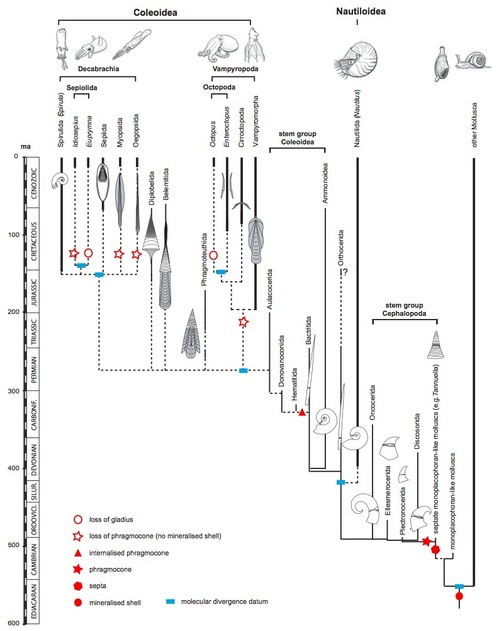|
|
Phylogenetics |
| Systematics |
Total Evidence approach |
Phylogenetics: Total Evidence approach

Cephalopod phylogeny. This interdisciplinary phylogenetic hypothesis resulting from the congruent picture emerging from fossils, development and molecules. First appearance of morphological traits are shown by solid red shapes, parallel loss of external or mineralised shell by open red shapes, molecular clock calibration by blue bars. Diagram from Kröger et al 2011 |
The tendency towards interdisciplinary and multidisciplinary studies, and a conscilience of knowledge, in large scale science in general, shows itself in phylogenetics in theTotal Evidence approach, which brings together data from as many fields as possible to understand and map out the history of life on Earth. For example, both molecular and morphological data can be processed both separately and together using the same computational analysis. Multiple statistical methodologies are now uniformly used and compared, such as testing both parsimony, maximum likelihood, and bayesian trees, with researchers selecting the best fit.
Stratigraphy is used in calibrating the various lineages and nodes by using the first fossil appearances. By these means, and using computational phylogeny, O'Leary et al 2013 were able to show that the placental mammal radiation post-dated the extinction of the dinosaurs, in contrast to both molecular-only calibration and earlier morphological trees, which placed the placental radiation deep in the Cretaceous. Another total evidence paper is Kröger et al 2011's synthesis of paleontology, developmental biology and molecular sequencing, as applied to Cephalopod origin and evolution. There tree is shown at the top of this page.
As always, there is scope for further methodologies to be incorporated. Sometimes the reluctance to do so is not practical but ideological. For example the tendency among many cladists to reject both stratocladistics and evolutionary gradism inspired the present author (MAK) to write the following essay arguing for a further synthesis. An example of a total approach of this sort is an intriguing paper on pachypleurosaur anagensis (straight line evolution), that combined stratigraphic, phenetic, and cladistic data and methodologies (O'Keefe & Sander 1999). Such methodologies are well-suited for analysing smaller groups well represented by the fossil record. Although this sort of pluralistic-integrated methodology is not yet widely applied, (prefernce being still given to large-scale phylogenetic reconstructions of the tree of life), there is no doubt that, as science progresses, more data from a more methodologies will be incorporated in increasingly wider total evidence phylogenetic analyses. MAK130414
